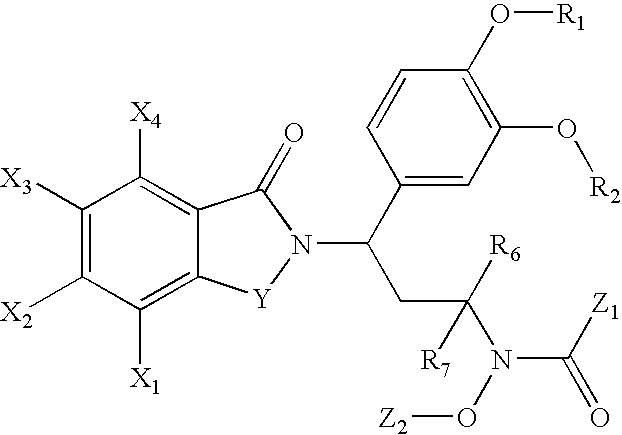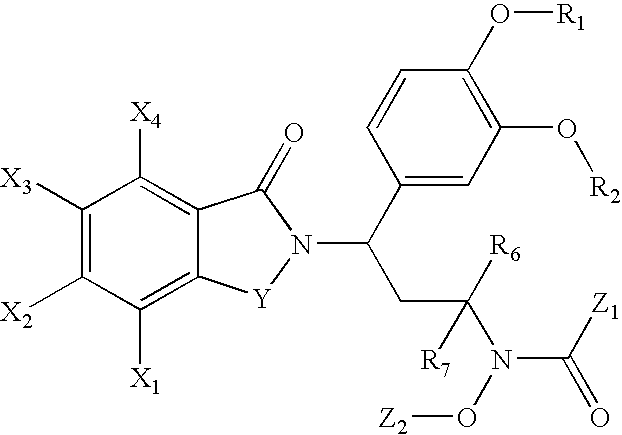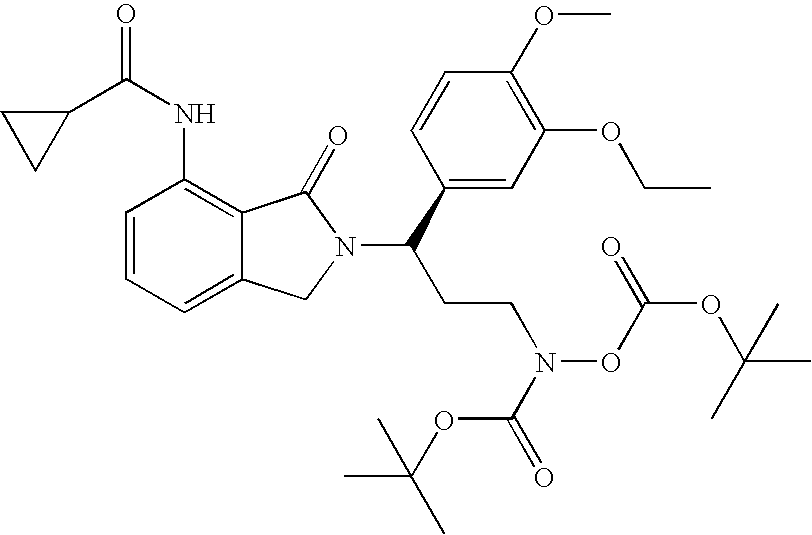N-alkyl-hydroxamic acid-isoindolyl compounds and their pharmaceutical uses
a technology of n-alkyl-hydroxamic acid and isoindolyl, which is applied in the direction of metabolism disorder, extracellular fluid disorder, immunological disorder, etc., can solve the problems of cancer being particularly devastating, the risk of the spread of cancer, and the breakdown of camp control in these cells
- Summary
- Abstract
- Description
- Claims
- Application Information
AI Technical Summary
Benefits of technology
Problems solved by technology
Method used
Image
Examples
example 1
5.1. Example 1
[0199](1R)-Cyclopropanecarboxylic acid {2-[1-(3-ethoxy-4-methoxy-phenyl)-3-hydroxy-propyl]-3-oxo-2,3-dihydro-1H-Isoindol-4-yl}-amide
[0200]A solution of (3R)-3-amino-3-(3-ethoxy-4-methoxy-phenyl)-propan-1-ol (1.1 g, 4.9 mmol), 2-bromomethyl-6-(cyclopropanecarbonyl-amino)-benzoic acid methyl ester (1.5 g, 4.8 mmol) and triethylamine (0.75 mL, 5.4 mmol) in DMF (10 mL) was heated at 100° C. for 18 h. The solvent was removed in vacuo. The residue was extracted with ethyl acetate (50 mL) and water (50 mL). The organic layer was washed with HCl (1N, 50 mL), brine (50 mL), and dried over MgSO4. The solvent was removed in vacuo to give an oil. The oil was stirred in ether (5 mL) and hexane (5 mL) to give a suspension. The suspension was filtered to give (1R)-cyclopropanecarboxylic acid {2-[1-(3-ethoxy-4-methoxy-phenyl)-3-hydroxy-propyl]-3-oxo-2,3-dihydro-1H-isoindol-4-yl}-amide as a white solid (1.3 g, 64% yield): mp, 103-105° C.; 1H NMR (CDCl3) δ 0.86-0.93 (m, 2H, CH2), 1.08-...
example 2
5.2. Example 2
(1R)-2-[1-(3-Ethoxy-4-methoxy-phenyl)-3-hydroxy-propyl]-7-nitro-2,3-dihydro-Isoindol-1-one
[0201]
[0202](1R)-2-[1-(3-Ethoxy-4-methoxy-phenyl)-3-hydroxy-propyl]-7-nitro-2,3-dihydro-isoindol-1-one was prepared by the procedure of Example 1 from (3R)-3-amino-3-(3-ethoxy-4-methoxy-phenyl)-propan-1-ol (3.0 g, 13 mmol), 2-bromomethyl-6-nitro-benzoic acid methyl ester (3.6 g, 13 mmol) and triethylamine (2 mL, 14 mmol) in DMF (40 mL) to give a yellow solid (4.1 g, 81% yield): 1H NMR (CDCl3) δ 1.44 (t, J=7 Hz, 3H, CH3), 2.13-2.31 (m, 2H, CH2), 3.54-3.59 (m, 1H, CHH), 3.71-3.77 (m, 1H, NCHH), 3.87 (s, 3H, CH3), 3.94 (d, J=16 Hz, 1H, NCHH), 4.06 (q, J=7 Hz, 2H, CH2), 4.26 (d, J=16 Hz, 1H, NCHH), 5.70 (dd, J=4, 11 Hz, 1H, NCH), 6.85-6.99 (m, 3H, Ar), 7.55-7.77 (m, 3H, Ar); 13C NMR (CDCl3) δ 14.76, 33.92, 45.80, 51.30, 55.98, 58.65, 64.63, 65.84, 111.39, 113.22, 119.75, 122.91, 124.13, 126.74, 130.66, 132.11, 143.84, 146.66, 148.68, 149.33, 164.22.
example 3
5.3. Example 3
(3R)-(tert-Butoxy)-N-{3-(3-ethoxy-4-methoxyphenyl)-3-[7-nitro-1-oxoisoindolin-2-yl]-propyl}carbonylamino (tert-butoxy)formate
[0203]
[0204]To a solution of (1R)-2-[1-(3-ethoxy-4-methoxy-phenyl)-3-hydroxy-propyl]-7-nitro-2,3-dihydro-isoindol-1-one (4.1 g, 11 mmol), (tert-butoxy)carbonylamino (tert-butoxy)formate (3.0 g, 13 mmol), and triphenylphosphine in THF (40 mL) was added diisopropyl azodicarboxylate (2.6 mL, 13 mmol) at room temperature. After 30 min, the solvent was removed in vacuo. The residue was purified with chromatography (Silica Gel) to give (3R)-(tert-butoxy)-N-{3-(3-ethoxy-4-methoxyphenyl)-3-[7-nitro-1-oxoisoindolin-2-yl]-propyl}carbonylamino (tert-butoxy)formate (5 g, 78% yield): 1H NMR (CDCl3) δ 1.41 (s, 9H, 3CH3), 1.42 (t, J=7 Hz, 3H, CH3), 1.51 (s, 9H, 3CH3), 2.39-2.52 (m, 2H, CH2), 3.59-3.69 (m, 2H, CH2), 3.84 (s, 3H, CH3), 4.06 (q, J=7 Hz, 2H, CH2), 4.11 (d, J=16 Hz, 1H, NCHH), 4.43 (d, J=16 Hz, 1H, NCHH), 5.47 (dd, J=7, 9 Hz, 1H, NCH), 6.81 (d, J=8 ...
PUM
| Property | Measurement | Unit |
|---|---|---|
| melting point | aaaaa | aaaaa |
| melting point | aaaaa | aaaaa |
| weight | aaaaa | aaaaa |
Abstract
Description
Claims
Application Information
 Login to View More
Login to View More - R&D
- Intellectual Property
- Life Sciences
- Materials
- Tech Scout
- Unparalleled Data Quality
- Higher Quality Content
- 60% Fewer Hallucinations
Browse by: Latest US Patents, China's latest patents, Technical Efficacy Thesaurus, Application Domain, Technology Topic, Popular Technical Reports.
© 2025 PatSnap. All rights reserved.Legal|Privacy policy|Modern Slavery Act Transparency Statement|Sitemap|About US| Contact US: help@patsnap.com



